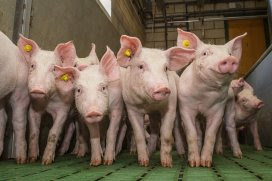Webinar Improve Pig Productivity

How to improve pig productivity? Can it be achieved by applying multi-phase feeding? Or choosing different climate solutions or perhaps looking at pig genetics? Find out more on February 9.
When aiming at the improvement of pig productivity, many solutions are usually focused on enhancing animal nutrition. After all, how could one more directly influence productivity than through feed? What is certain, however, is that there is a host of other options available as well. That is where our search begins on February 9. Pig Progress shall highlight several of these strategies in an exclusive webinar, brought to you live from Amsterdam, the Netherlands (CET 11.00 -12.00 am). The following speakers shall be sharing their views:
|
1. Product Manager Pigs Ludo Bosschaerts: International, independent research has proven that multi-phase feeding produces better feed conversion ratio’s (FCR) and has a positive impact on average daily gain (ADG). A better retention of nutrients in the body has been found and a significant reduction in the production of manure, resulting in a lower expulsion of ammonium gasses into the environment. This Roxell concept results in a high return on investment. |
|
|
2. Merete Lyngbye, Master of Engineering, PhD, Director for Livestock Segment at Munters will speak about climate solutions to improve pig producers economy and environmental footprint. |
|
|
3. Benny van Haandel. Director/consultant at E-barn Solutions will give a presentation titled ‘Are our current pig genetics future proof?’ “How do new developments in various areas and markets affect the required characteristics of future top performing pigs?††|
Hosted by Vincent ter Beek, editor of Pig Progress, the live webinar offers you the opportunity to exchange ideas with experts in real time.
Tuesday
9
February 2016
starts at 11:00 AM CET












